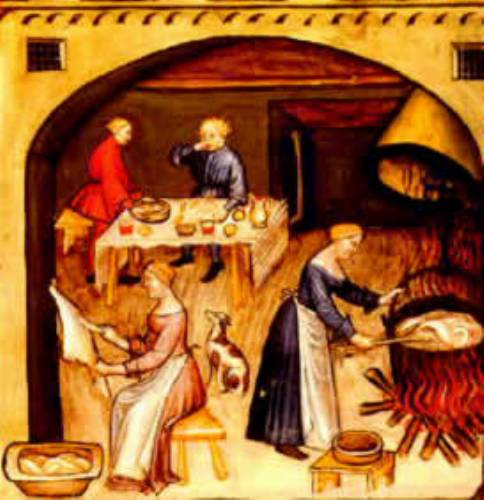 Etwas aufwendiger, dafür aber der Hingucker auf jedem festlichen Büffet, sind die Dörräpfel, die mit Äpfeln so rein gar nichts gemein haben – abgesehen vom Aussehen. Es handelt sich um ein Scheingericht, das in England bereits im 15. Jahrhundert bekannt war.
Etwas aufwendiger, dafür aber der Hingucker auf jedem festlichen Büffet, sind die Dörräpfel, die mit Äpfeln so rein gar nichts gemein haben – abgesehen vom Aussehen. Es handelt sich um ein Scheingericht, das in England bereits im 15. Jahrhundert bekannt war.
Erwähnt wird es bei Maredudd Angharad ferch Gwenhyfar, The Stewpot Period Culinary Guild (SCA)
These Pommes Dorres are based upon three recipes from the Harleian MS 279 (c. 1420) that have been published by Cindy Renfrow. Although the primary recipe is xix. Pomme Dorres, three recipes were combined to provide a combination of flavors which would be flavorful, and to achieve the goal of a beautiful and tasty spectacle food product. Comparison with similar recipes indicates that, as usual, considerable leeway is available to the cook in making such meatballs. (Hieatt, no. 28)
Subtleties or entremets began primarily as mere fillers in the middle of a meal. They were literally presented ‘between’ the ‘services’ and were generally simple foods designed to create a pause so that the diner’s palate not become jaded with a surfeit of delight and so that the dishes coming in the subsequent course(s) might be appreciated all the more (Scully p. 104).
Beginning as a simple food, the dishes were first identified as entrements in Viander in about 1300. As time went on, cooks began to experiment with unusual colors and forms, such as a checkerboard pattern, perhaps with multiple textures and appearances. (Scully p. 106).
By the beginning of the fifteenth century, the tradition developed into a grandiose spectacle. The most common festive subject is a representation in sugar of persons or objects. These later entremets were not edible or only partially edible.
These Pommes Dorres are completely edible. Constructed of ground meat, spices and a batter for the endoring, they represent green and gold apples. Another color you may want to experiment with is saunders or sandalwood, which will produce a rich dark brick red color. Grind the sandalwood to powder in your spice grinder and add to the basic batter. I’ve used sandalwood to create pomegranates.
Übersetzung (sinngemäß):
Diese Dörräpfel basieren auf drei Rezepte aus dem Harleian MS 279 (ca. 1420), die von Cindy Renfrow veröffentlicht wurden. Obwohl das Hauptrezept das xix. Pomme Dorres ist, wurden hier drei Rezepte kombiniert, um ein Zusammenspiel von Aromen anzubieten, die sich geschmacklich ergänzen, und um aus diesem Gericht ein wirkliches Geschmackserlebnis zu kreieren. Der Vergleich mit ähnlichen Rezepten hat gezeigt, das es für die jeweiligen Köchen nicht unerheblichen Spielraum bei der Zubereitung dieser Fleischklöße gab. (Hieatt, no. 28)
Schein- oder Zwischengerichte fungierten ursprünglich rein als Pausenfüller in der Mitte einer Mahlzeit. Sie wurden wortwörtlich „zwischen“ den einzelnen Gängen serviert und waren normalerweise einfache Speisen, die dazu dienten, eine kurze Unterbrechung in der Speisenfolge zu gewährleisten, damit der Gaumen der Speisenden nicht durch eine Übersättigung durch zu viele Genüsse abstumpfte und die anschließenden Gänge möglichst noch mehr genossen und wertgeschätzt werden konnten. (Scully p. 104)
Anfangs nur einfache Speisen, wurden diese Gerichte zunächst im Viander um 1300 als Zwischengerichte bezeichnet. Im Laufe der Zeit begannen die Köche mit ungewöhnlichen Farben und Formen zu experimentieren, wie z. B. mit dem Schachbrettmuster, vermutlich mit mannigfaltigen Konsistenzen und Erscheinungsformen. (Scully p. 106)
Zum Ende des 15. Jahrhunderts hatte sich diese Tradition zu einem grandiosen Spektakel gewandelt. Das beliebteste Objekt bei Festlichkeiten war die Repräsentation einer Person oder eines Gegenstands aus Zucker. Diese späteren Zwischengerichte waren nicht oder nur teilweise essbar.
Diese Dörräpfel sind vollständig essbar. Sie bestehen aus Hackfleisch, Gewürzen und einem Teig außen herum , der ihnen Das aussehen von grünen und goldenen Äpfeln gibt. Eine andere Farbe, mit der man experimentieren kann, ist Sandelholz, das ein dunkles Ziegelsteinrot hervorbringt. Dazu wird das Sandelholz im Mörser zu feinem Puder vermahlen und dem Grundteig zugesetzt. Sandelholz kann zum Beispiel benutzt werden, um Granatäpfel herzustellen.
xix. Pomme dorres.
Take fylettys of Raw porke, & grynd hem wyl; do Salt and pouder Pepir ther-to; than take the Whyte of the Eyroun and throw ther-to, & make hem so hard that they mow ben Rosted on a Spete; make hem round as an Appil: make fyre with-owte smoke; then take Almaunde mylke, and y-bontyd flour, do hem to-gederys take Sugre, & putte in thin bature; then dore hem with sum grene thing, percely or yolks of Eyroun, to-geder, that they ben grene; & be wyl war that that they be nowt Browne; & sum men boyle hem in freysshe broth or they be spetid; & whan they ben so boylid, then they must ben sette an kelid, than Spete hem, & dore hem with the yolkys of Eyroun y-mengyd with the Ius of haselle leuys.
Take Fillets of Raw pork, & grind them well; put Salt and powdered Pepper thereto; the take the White of the Egg and throw thereto, & make them so hard that they might be Roasted on a Spit; make them round as an Apple: make fire without smoke; then take Almond milk, & sifted flour, put them together; take Sugar, & put in thine batter; then glaze them with some green thing, parsley or yolks or Egg, together, that they are green; & be well aware that they are not Brown; & some men boil them in fresh broth before they are spitted; & when they are so boiled, then they must be set and cooled, & then Spit them, & glaze then with the yolks of Eggs mixed with the juice of hazel leaves.
(Harleian MS. 279, Leche Vyaundez)
xxiij. Pome-Garnez.
Take lene Raw Pork, & lene raw Flesshe of hennys, & raw eyroun, & rent the flesshe fro the bonys, & hew it smal; take thanne Salt, Gyngere, & Safroun, Salt, Galyngale, ther-of y-now, & caste it in a morter, & bray it smal; take than thin fleysshe, & caste it in-to that morter to the Spycery, & that it wyl y-grounde; thanne make ther-of pelettys, as it were Applys, be-twene thin hondys; loke thou haue fayre panne sething ouere the fyre, & do ther-on thin pelettys, & late hem nowt sethe to swythe, & than lat hem kele; & whan they ben cold, gif hem a fayre spete of haselle, & be-twyn euery, loke ther be an ynche, & lay hem to the fyre: & than make thin baturys, the on grene, & that other yelow; the grene of Percely.
Take lean Raw Pork, & lean raw Flesh of hens, & raw eggs, & rend the flesh from the bones, & hew it small; take then Salt, Ginger, & Saffron, Salt, Galingale, thereof enough, & cast it in a mortar, & bray it small; take then thine flesh, & cast it into that mortar to the Spicery, & that it is well ground; then make therof pellets, as it were Apples , between thine hands; look thou have a fair pan seething over the fire, & put theron thine pellets, & let them not seethe too quickly, & when they are cold, give them a fair spit of hazel, and between every, look there be an inch, & lay them to the fire: & then make thine batters, the one green, & that other yellow; the green of Parsley.
(Harleian MS. 279, Leche Vyaundez)
Cxxxviij. Pumpes.
Take an sethe a gode gobet of Porke, & nogt to lene, as tendyr as thou may; than take hem vppe & choppe hem as smal as thou may; than take clowes & Maces, & choppe forth with-alle, & Also choppe forth with Roysonys of coraunce; than take hem & rolle hem as round as thou may, lyke to smale pelettys, a .ij. inches a-bowte, than ley hem on a dysshe be hem selue; than make a gode Almaunde mylke, & a lye it with floure of Rys, & lat it boyle wyl, but loke that it be clene rennyng; & at the dressoure, ley .v. pompys in a dysshe, & pore thin potage ther-on. An gif thou wolt, sette on euery pompe a flos campy flour, & a boue straw on Sugre y-now, & Maces: & serue hem forth. And sum men make the pellettys of vele or Beeff, but porke ys beste & fayrest.
Meatballs. Take and seethe a good gobbet of Pork, & not to lean, as tender as thou may; than take them up & chop them as small as thou may; than take cloves & Maces, & chop forth withal, & Also chop forth with Raisins of Corinth; then take them & roll them as round as thou may, like to small pellets, at two inches round, than lay them on a dish by themselves; then make a good Almond milk, & and mix it with flour of Rice, & let it boil well, but look that it be clean running; & at the dresser, lay five meatballs in a dish, & pour thine pottage thereon. An if thou wilt, set on every meatball a field flower, & above strew on Suger enough, & Maces: & serve them forth. And some men make the pellets of veal or Beef, but pork is best & fairest.
(Harleian MS. 279, Potage Dyvers)
Das komplette Rezept mit Zutaten und Zubereitungs- sowie Quellenangabe befindet sich in meiner Mittelalter-Rezept-Datenbank:
http://www.petra-schier.de/html/schwein.html#Doerraepfel
- Über mich
- Neueste Beiträge
Petra Schier, Jahrgang 1978, lebt mit Mann und Hund in einer kleinen Gemeinde in der Eifel. Sie studierte Geschichte und Literatur und arbeitet seit 2003 als freie Autorin. Ihre historischen Romane erscheinen im Rowohlt Taschenbuch Verlag, ihre Weihnachtsromane bei Rütten & Loening sowie MIRA Taschenbuch.
Unter dem Pseudonym Mila Roth veröffentlicht die Autorin verlagsunabhängig verschiedene erfolgreiche Buchserien.
Petra Schier ist Mitglied in folgenden Autorenvereinigungen: DELIA, Syndikat, Autorenforum Montségur




Noch keine Kommentare